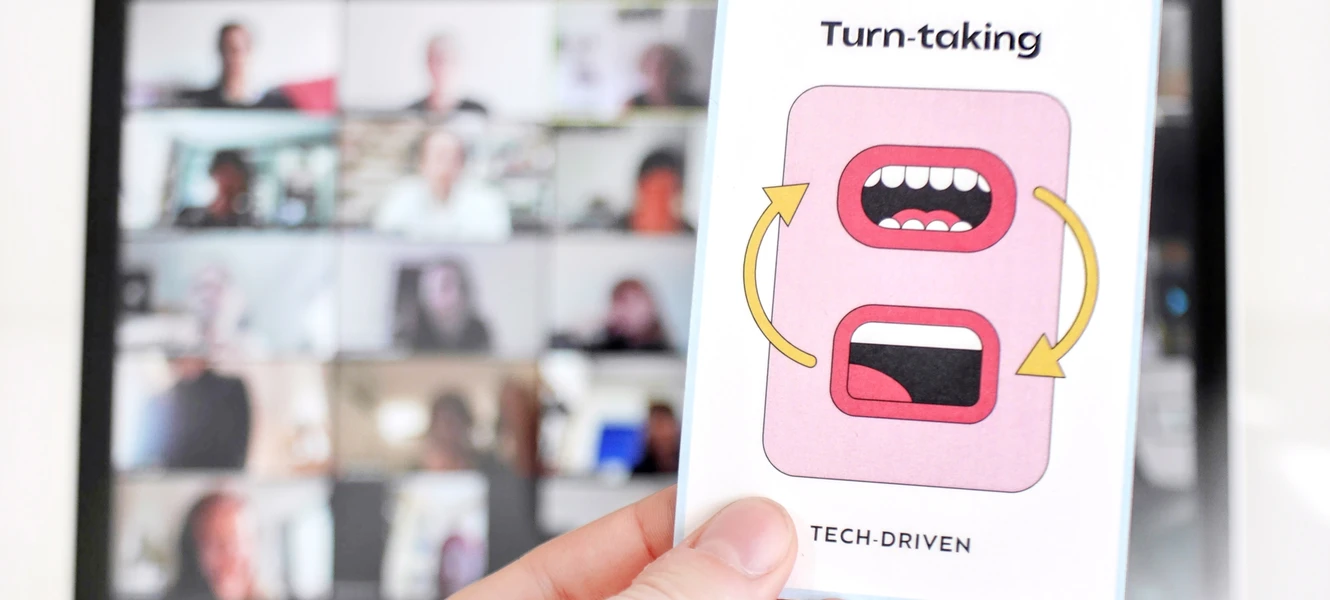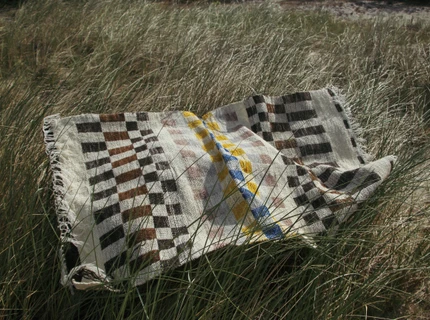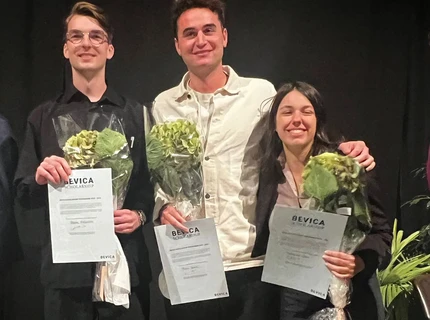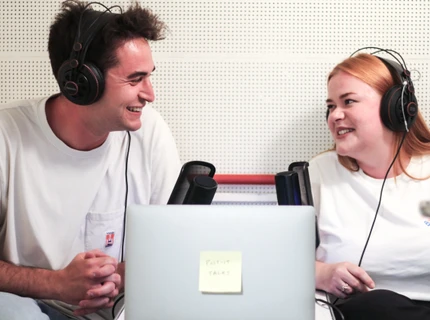
The creative hurdle
During the spring corona shutdown, the future graduates from Design School Kolding were cut off from the workshops and the research that were absolutely critical to their design projects. But some turned this hurdle into inspiration which revealed entirely new opportunities – with creative video filters, glittering handbags and anti-virus masks for the end of the tunnel.
Sparkling coloured filtres, a virtual high five to a colleague, a glide in a futuristic landscape and other digital delicacies that give the traditional meeting killer – the video conference – a substantial face lift. A handbag, woven from an old wedding dress and fabric remnants sprinkled with exclusive crystals. And a mask that – who knows – may become a ground-breaking step in the fight against corona, even with sustainability added to the equation.
These are some examples of the design solutions that young, newly graduated designers from Design School Kolding present this year as their graduation projects. What characterises all the solutions is that the global corona pandemic has had a radical impact on the projects.
Video conferences – from the epitome of boredom to a digital party
One example is Zuzanna Gronowicz's Master's project in Design for Play, Virtual Future Experiments, which brings new life to the indispensable but often deadly boring video conference of the time. She explains:
– The shutdown gave me a unique opportunity to dive into what digital communication of the future might look like, not least because the adaptation period, which would normally have lasted several years, was now suddenly boiled down to, well, sometimes only a few days, when everyone suddenly had to meet in virtual spaces instead of face-to-face – something that was difficult for many people and resulted in poor mental well-being, says Zuzanna.
– Therefore, I dived into the virtual world and soaked up inspiration from chats, games, Virtual Reality and of course a lot of interactions, and on that basis I developed a much more playful approach to being together in the digital space.
The result is a toolbox of creative inspirational cards that demonstrate the designer's insight into people's behaviour in the digital space – whether it's speed talkers, vacuum cleaners in the background or ways to tackle shyness. The cards are now freely available to other creative developers of digital experiences. At the same time, Zuzanna has used her insight to develop an entire portfolio of fun, intuitive and inclusive functionalities that show how to spice up the boring video conference and tackle the challenges that arise when a host of users are thrown into a new form of contact.
Mask fights corona with antivirus technology
The corona pandemic also came to play a crucial role for Sara Lee Krog in her graduation project as a Master in Design for People. Originally, when the pandemic broke out, she was working on a project about how textile wall panels could absorb pollution. That inspired her to transfer the principles from the panels to a face mask that can deactivate dangerous viruses – potentially even SARS-CoV-2, also known as the coronavirus, which causes COVID-19.
In collaboration with researchers in areas such as virology and chemistry, she has developed a mask that – briefly – is constructed of two layers of fabric combined with a substance that contains a chemical component. When this component is activated electronically, reactive atoms are formed that neutralise the dangerous virus. Virologists are currently testing the ability of the mask to fight corona. An additional benefit of the mask is that it is reusable. Thus it differs from the millions, perhaps even billions of disposable facemasks that are currently used worldwide and often end up as rubbish on the streets, in nature and in the oceans.
Pieces of a wedding dress – and a therapeutic loom
While Sara Lee Krog reached out to the entire world in connection with her mask project, Annesofie Bundell's Bachelor project in Accessory Design is fundamentally introspective, almost meditative. In her involuntary corona exile, she had to find both inspiration and materials in her immediate vicinity in order to design and shape the handbag collection she developed for the crystal manufacturer Swarowski. Hence, the bags ended up being woven in silk from a wedding dress, remnants of model fabric and old clothes, all retrieved in her flat, and then decorated with Swarowski crystals. At the same time, the process itself became a kind of survival strategy in this strange, shut-down spring.
– The pandemic had a fundamental impact on my collection because I was all by myself in my flat, only surrounded by my work, so I had to come up with something that made it a little fun and less stressful. My weaving became almost completely therapeutic, because I could listen to music and talk to friends on FaceTime, while at the same time feeling at ease and closely connected with my materials, she says.
Crises require new thinking
It is not an unknown phenomenon that crises and disasters pave the way for new thinking. Whether it has been epidemics, economic depression, natural disasters or even war, crises have always led to a need to live and produce in new ways – and they have thus kick-started technological or societal advances, such as the invention of vaccines, tsunami alert systems or the redistribution of society's resources and increased equality.
Lene Tanggaard, Rector of Design School Kolding and professor of psychology, is one of the country's leading researchers in creativity and she has, among other things, studied to what extent our ability to create is impacted when we are suddenly presented with hurdles. She says:
– During the Corona pandemic, it’s not only the students who have had to reinvent themselves. Businesses have had to devise new business methods; teaching has gone online; our Friday bar with friends and colleagues now takes place via Zoom. In short: we have been exposed to an enormous creative hurdle. We are talking about collapse in a radical sense, which is by no means desirable, but which at the same time challenges us, in a positive fashion, to look critically at how we normally do things. In reality, crisis means a turning point. And this is exactly what designers take as their starting point when they work. They look at what is and examine how it can be done better.
Experience the designs at the Museum at Koldinghus where they will be on display until 22 November 2020. You can also enjoy them online.
“What characterises all the solutions is that the global corona pandemic has had a radical impact on the projects.”


